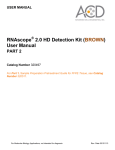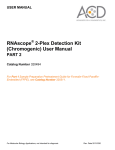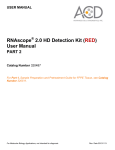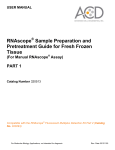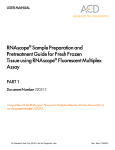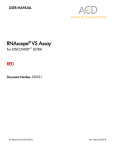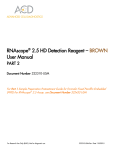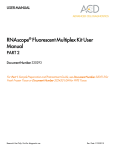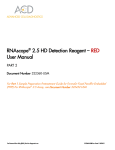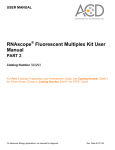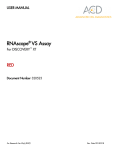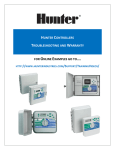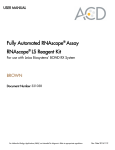Download - Advanced Cell Diagnostics
Transcript
USER MANUAL RNAscope® Sample Preparation and Pretreatment Guide for FFPE Tissue PART 1 Catalog Number 320511 Compatible with the following User Manuals: RNAscope® 2.0 HD Detection Kit – BROWN (Catalog No. 320497), RNAscope® 2.0 HD Detection Kit – RED (Catalog No. 320487), and RNAscope® 2-Plex Detection Kit – Chromogenic (Catalog No. 320494). For Molecular Biology Applications, not intended for diagnosis. Rev. Date 20130628 For Molecular Biology Applications, not intended for diagnosis. Trademarks RNAscope® and HybEZ™ are trademarks of Advanced Cell Diagnostics, Inc. All other trademarks belong to their respective owners. Citing RNAscope® 2.0 in Publications When describing a procedure for publication using this product, please refer to it as the RNAscope® 2.0 Assay and cite: Wang F, Flanagan J, Su N, Wang L-C, Bui S, Nielson A, Wu X, Vo H-T, Ma X-J and Luo Y. RNAscope: A Novel In Situ RNA Analysis Platform for Formalin-Fixed Paraffin-Embedded Tissues. J. Mol. Diagnostics, 2012, 14:22–29. Disclaimers Advanced Cell Diagnostics, Inc. reserves the right to change its products and services at any time to incorporate technological developments. This manual is subject to change without notice. Although this manual has been prepared with every precaution to ensure accuracy, Advanced Cell Diagnostics, Inc. assumes no liability for any errors, omissions, or for any damages resulting from the use of this information. Copyright © 2013. Advanced Cell Diagnostics, Inc. All rights reserved. Contents Chapter 1. Product Information .......................................................5 About this guide ............................................................................................... 5 Product description .......................................................................................... 5 Background.................................................................................................. 5 Sample types ............................................................................................... 5 RNAscope® Assay reagents ........................................................................ 6 RNAscope® Reagent Kit .............................................................................. 6 Required materials and equipment ................................................................. 7 HybEZ™ Hybridization System .................................................................... 7 User-supplied materials ............................................................................... 7 Chapter 2. Before You Begin ...........................................................9 Important procedural guidelines ...................................................................... 9 Chapter 3. Prepare and Pretreat Samples..................................... 11 Prepare FFPE sections ................................................................................. 11 Materials required ...................................................................................... 11 Fix the sample ........................................................................................... 11 Dehydrate, embed, and cut the sample .................................................... 12 Prepare FFPE slides for the RNAscope® Assay ........................................... 12 Workflow .................................................................................................... 12 Materials required ...................................................................................... 13 Bake slides ................................................................................................ 13 Deparaffinize FFPE sections ..................................................................... 13 Pretreat samples ........................................................................................... 14 Workflow .................................................................................................... 14 Materials required ...................................................................................... 15 Equilibrate equipment ................................................................................ 15 Prepare 1X Pretreat 2 ................................................................................ 15 Apply Pretreat 1 ......................................................................................... 15 Apply Pretreat 2 ......................................................................................... 16 Create a hydrophobic barrier ..................................................................... 16 Apply Pretreat 3 ......................................................................................... 17 Proceed to the RNAscope® Assay ................................................................ 17 Troubleshooting ............................................................................................. 17 Appendix A. Tissue Pretreatment Recommendation ................... 19 Tissue pretreatment recommendation........................................................... 19 Tissue-specific pretreatment conditions .................................................... 19 Appendix B. Reagent Volume Guidelines ..................................... 21 Determine reagent volume ............................................................................ 21 Appendix C. Safety .........................................................................23 Sample Preparation and Pretreatment Guide for FFPE Tissue 3 Chemical safety ............................................................................................. 23 Biological hazard safety................................................................................. 23 Documentation and support ..........................................................25 Obtaining MSDSs .......................................................................................... 25 Obtaining support .......................................................................................... 25 Contact information ....................................................................................... 25 Limited product warranty ............................................................................... 25 4 Sample Preparation and Pretreatment Guide for FFPE Tissue Chapter 1. Product Information 1 Before using this product, read and understand the information in Appendix C. Safety on page 23 in this document. IMPORTANT! We recommend reading the entire user manual before beginning any protocols. About this guide This user manual provides guidelines and protocols for the proper preparation and pretreatment of formalin-fixed, paraffin-embedded (FFPE) tissues mounted on slides. The slides can then be assayed using an RNAscope® Detection Kit. RNAscope® Reagent Kits come with a separate RNAscope® Assay User Manual. Do not perform an RNAscope® Assay without the correct user manual. Refer to the manuals available at www.acdbio.com/support/technical-doc for more details. For any questions, please contact [email protected]. Product description Background The RNAscope® Assays use a novel and proprietary method of in situ hybridization (ISH) to visualize single RNA molecules per cell in samples mounted on slides. The assays are based on ACD’s patented signal amplification and background suppression technology. Proprietary RNA-specific probes are hybridized to target RNA, and are then bound to a cascade of signal amplification molecules culminating in signal detection (Figure 1). Single-plex, 2-plex, multiplex and automated assays are all available. The RNAscope® Assay procedure is illustrated in Figure 1 on page 6 and can be completed in 6–10 hours depending on the assay, or conveniently divided over two days. Most RNAscope® Assay reagents are available in convenient Ready-To-Use (RTU) dropper bottles and provide a simple, nearly pipette-free workflow. Results are observable using standard bright field or fluorescent microscopy. Sample types In order to perform the RNAscope® Assays, you must start with properly prepared and pretreated samples. Multiple sample types are now compatible with RNAscope® Assays and include: formalin-fixed paraffin-embedded (FFPE) tissues, fresh frozen tissues, fixed frozen tissues, tissue microarray (TMA), and cultured cells. Visit www.acdbio.com and contact [email protected] for more information. Sample Preparation and Pretreatment Guide for FFPE Tissue 5 Figure 1 Procedure overview 1: Tissue section 2: Hybridize to target RNA Start with properly prepared sections and pretreat to allow access to target RNA. Hybridize gene-specific probe pairs to the target mRNA. 3: Amplify signal 4: Image Probes are hybridized to a cascade of signal amplification molecules, culminating in binding of HRP- or AP-labeled probes. The 2.0 Assay enhances signal further with additional amplification steps. Add DAB or Fast Red substrate to detect target RNA. Visualize target RNA using a standard bright field microscope. RNAscope® Assay reagents RNAscope® Assays require the RNAscope® Probes and an RNAscope® Detection Kit. If you are performing an automated assay using the Ventana® DISCOVERY XT or ULTRA Systems, you must use RNAscope® VS Probes and the RNAscope® VS Reagent Kit. Probes and Reagent Kits are available separately. Visitwww.acdbio.com/products/target-probes/search-product to find a gene-specific probe from a searchable catalog of >27,000 predesigned Target Probes, or order a custom probe. Visit www.acdbio.com/products/target-probes/controls-housekeeping to find appropriate Control Probes. RNAscope® Reagent Kit Each RNAscope® Detection Kit provides enough reagents to stain ~20 tissue sections approximately 20 mm x 20 mm large. Larger tissue sections will result in fewer tests. Each kit contains three sub-kits including a Pretreatment Kit (Cat. no. 310020). Pretreatment Kit instructions are provided in this guide. For information on the other sub-kits and directions for use, refer to an RNAscope® Detection Kit User Manual. The reagents have a shelf life of six months from the shipment date when stored as indicated in the following table: Pretreatment Kit (Cat. no. 310020) Reagent Quantity Storage Pretreat 1 — Ready-To-Use (RTU) endogenous blocker 4 mL x 2 bottles 4°C 10X Pretreat 2* 70 mL x 4 bottles Room temperature (20–25°C) Pretreat 3 — RTU† protease 4.5 mL x 1 bottle 4°C * Comes in a separate box. † Dilute Pretreat 3 for some samples. See Appendix A. Tissue Pretreatment Guidelines on page 19. 6 Sample Preparation and Pretreatment Guide for FFPE Tissue Required materials and equipment The following materials and equipment are needed to perform the RNAscope® Assay. HybEZ™ Hybridization System IMPORTANT! The RNAscope® Assay has been validated using this system only. The HybEZ™ Hybridization System (110 VAC, Cat. no. 310010; 220 VAC, Cat. no. 310013) is designed for the hybridization and incubation steps in the RNAscope® Assays. Incubation steps in the RNAscope® Assay require humid conditions to prevent sections from drying out. For instructions on how to use the HybEZ™ Hybridization System, refer to the HybEZ™ Hybridization System User Manual available at www.acdbio.com/support/technical-doc and view the training video at www.acdbio.com/support/online-training-videos. The system contains the following components: Component Quantity Cat. no. HybEZ™ Oven (110 or 220 VAC) 1 oven 310010 or 310013 HybEZ™ Humidity Control Tray (with lid) 1 tray 310012 HybEZ™ Slide Rack (20 slide capacity) 1 rack 310014 HybEZ™ Humidifying Paper 2 sheets — HybEZ™ Humidifying Paper Pack 15 sheets 310015 User-supplied materials IMPORTANT! Do not substitute other materials for the ImmEdge™ Hydrophobic Barrier Pen and the SuperFrost® Plus Slides listed in the following table. Description Supplier Cat. no. ImmEdge™ Hydrophobic Barrier Pen (required) Vector Laboratory H-4000 SuperFrost® Plus Slides (required) Fisher Scientific 12-550-15 100% ethanol American Master Tech Scientific/MLS* ALREAGAL Gill’s Hematoxylin I American Master Tech Scientific/MLS HXGHE1LT Xylene Fisher Scientific/MLS X3P-1GAL Tissue-Tek® Vertical 24 Slide Rack American Master Tech Scientific/MLS LWSRA24 Tissue-Tek® Staining Dish (6 required) American Master Tech Scientific/MLS LWT4457EA Tissue-Tek® Clearing Agent Dish, xylene resistant (3 required) American Master Tech Scientific/MLS LWT4456EA Cytoseal XYL xylene-based mounting medium Richard-Allen Scientific/MLS 8312-4 Cover Glass 24 x 50 mm Fisher Scientific/MLS 12--545-F Sample Preparation and Pretreatment Guide for FFPE Tissue 7 Description Supplier Cat. no. Ammonium hydroxide, 28–30% Sigma-Aldrich/MLS 320145-500mL Carboy (>3L) MLS — Water bath or incubator, capable of holding temperature at 40 +/- 1°C MLS — Pipettors and tips, 1–1000 µL MLS — Distilled water MLS — Tubes (various sizes) MLS — Fume hood MLS — Graduated cylinder MLS — Parafilm MLS — Paper towel or absorbent paper MLS — Glass beaker (1 or 2 L) MLS — Hot plate Fisher Scientific/MLS 11-300-49SHP Aluminum foil MLS — Forceps, large MLS — Thermometer MLS — 20% bleach MLS — Microscope and accessories MLS — 10% neutral-buffered formalin (NBF) MLS — Paraffin wax MLS — Microtome MLS — Drying oven, capable of holding temperature at 60 +/- 1°C MLS — * Major Laboratory Supplier in North America. For other regions, please check Catalog Numbers with your local lab supplier. 8 Sample Preparation and Pretreatment Guide for FFPE Tissue 2 Chapter 2. Before You Begin Prior to running the RNAscope® Assay on your samples for the first time, we recommend that you: • View the video demonstrations available at www.acdbio.com/support/online-trainingvideos. • Run the assay on FFPE RNAscope® Control Slides (Cat. no. 310045 for Human control slide, Hela; Catalog No. 310023 for Mouse control slide, 3T3) using the Positive and Negative Control Probes. Important procedural guidelines • Start with properly fixed and prepared sections. Refer to Chapter 3. Prepare and Pretreat Samples on page 11 for preparation of FFPE slides. For preparation of other sample types, contact [email protected]. • Follow the recommended pretreatment guidelines for your sample. Refer to Appendix A. Tissue Pretreatment Recommendations on page 19 for pretreatment conditions. • Always run positive and negative control probes on your sample to assess sample RNA quality and optimal permeabilization. • Do not substitute required materials. Assay has been validated with these materials only. • Follow the protocol exactly for best results. • Use good laboratory practices and follow all necessary safety procedures. Refer to Appendix C. Safety on page 23 for more information. Sample Preparation and Pretreatment Guide for FFPE Tissue 9 10 Sample Preparation and Pretreatment Guide for FFPE Tissue Chapter 3. Prepare and Pretreat Samples 3 Formalin-fixed, paraffin-embedded (FFPE) sample preparation and pretreatment are described in the following protocols. For other sample types and preparation methods, contact [email protected] for the latest protocols and guidelines. IMPORTANT! We highly recommend following these guidelines. We cannot guarantee assay results with other preparation methods. For suboptimally treated samples, you may need to optimize pretreatment conditions. Refer to Appendix A. Tissue Pretreatment Recommendations on page 19. Prepare FFPE sections Materials required • 10% neutral buffered formalin (NBF) • 1X PBS • Paraffin wax • 100% ethanol, ACS grade or equivalent • Xylene • Microtome • Water bath • SuperFrost® Plus slides Fix the sample 1. Remove sample and CUT 3–4 mm pieces prior to fixing. CAUTION! Handle biological specimens appropriately. 2. Fix sample in FRESH 10% NBF for 16–32 HOURS at ROOM TEMPERATURE. Fixation time will vary depending on tissue type. IMPORTANT! Under-fixation will result in significant signal loss when performing the RNAscope® Assay. Sample Preparation and Pretreatment Guide for FFPE Tissue 11 Dehydrate, embed, and cut the sample IMPORTANT! Use fresh reagents. 1. WASH sample with 1X PBS. 2. DEHYDRATE sample using a standard ETHANOL series, followed by XYLENE. 3. EMBED sample in PARAFFIN. Note: Embedded samples may be stored at room temperature for years. 4. Trim paraffin blocks as needed, and CUT embedded tissue into 5 +/- 1 μm sections using a microtome. 5. Place paraffin ribbon in water bath, and MOUNT sections on SUPERFROST® PLUS SLIDES. IMPORTANT! Place sections in the center of the slide. 6. AIR DRY slides OVERNIGHT at ROOM TEMPERATURE. Do NOT bake slides unless they will be used within 1 week. OPTIONAL STOPPING POINT (1). Use sectioned tissue within 3 months. Store sections with dessicants at room temperature. Prepare FFPE slides for the RNAscope® Assay Workflow Bake slides ~1 hour (Optional) 1 week Stopping Point (2) Deparaffinize FFPE tissue ~20 minutes (Optional) Overnight Stopping Point (3) 12 Sample Preparation and Pretreatment Guide for FFPE Tissue Materials required • Drying oven • Prepared FFPE slides • Tissue-Tek® Vertical 24 Slide Rack • Distilled water • Fume hood • Xylene • 100% ethanol • Tissue-Tek® Clearing Agent Dish (2) • Tissue-Tek® Staining Dish (2) • ImmEdge™ Hydrophobic Barrier Pen Bake slides 1. Bake slides in a dry oven for 1 HOUR at 60°C. OPTIONAL STOPPING POINT (2). Use sectioned tissue within 1 week. Store sections with dessicants at room temperature. 2. If you continue, prepare the materials for the following protocols while the slides are baking: Deparaffinize FFPE sections on page 13 and PRETREAT SAMPLES on page 15. Deparaffinize FFPE sections Reagents may be prepared ahead of time. Ensure all containers remain covered. • In a fume hood, fill TWO Clearing Agent DISHES with ~200 mL FRESH XYLENE. • In a fume hood, fill TWO Staining DISHES with ~200 mL FRESH 100% ETHANOL. 1. Place slides in a Tissue-Tek® Slide Rack and submerge in the first xylene-containing Clearing Agent Dish in the fume hood. 2. Incubate the slides in XYLENE for 5 MINUTES at ROOM TEMPERATURE. Agitate the slides by occasionally lifting the slide rack up and down in the Clearing Agent Dish. 3. Remove the slide rack from the first xylene-containing dish and immediately place in the second xylene-containing Clearing Agent Dish in the fume hood. 4. REPEAT STEP 2. 5. Remove the slide rack from the second xylene-containing dish and immediately place in the Staining Dish containing 100% ethanol. 6. Incubate the slides in 100% ETHANOL for 1 MINUTE at ROOM TEMPERATURE with agitation. 7. REPEAT STEP 6 with FRESH 100% ETHANOL. 8. Remove the slides from the rack, and place on absorbent paper with the section face-up. AIR DRY for 5 MINUTES at ROOM TEMPERATURE. OPTIONAL STOPPING POINT (3). Air dry overnight at room temperature (must use within 24 hours) or proceed directly to the next step. Sample Preparation and Pretreatment Guide for FFPE Tissue 13 Pretreat samples IMPORTANT! Before you begin, make sure you know the pretreatment conditions specific to your sample type. Refer to Appendix A. Tissue Pretreatment Recommendations on page 19. Workflow Equilibrate equipment and prepare 1X Pretreat 2 Turn on HybEZ™ OVEN. Place a Humidifying Paper in the Humidity Control Tray Insert covered tray into oven and close the oven door. WARM the TRAY for 30 MINUTES at 40°C before use. Prepare 1X Pretreat 2 ~10–20 minutes Apply Pretreat 1 ~10 minutes Apply Pretreat 2 ~10–30 minutes Create Hydrophobic barrier (Optional) Overnight Stopping Point (4) Apply Pretreat 3 ~30–60 minutes Proceed IMMEDIATELY to the RNAscope® 2.0 Assay* * Immediately proceed to the RNAscope® Assay Chapter of the appropriate Part 2 User Manual: RNAscope® 2.0 HD Detection Kit – BROWN (Catalog No. 320497), RNAscope® 2.0 HD Detection Kit – RED (Catalog No. 320487), and RNAscope® 2-Plex Detection Kit – Chromogenic (Catalog No. 320494). 14 Sample Preparation and Pretreatment Guide for FFPE Tissue Materials required Materials provided by Advanced Cell Diagnostics Other materials and equipment • Pretreat 1 • Prepared slides • Pretreat 2 • Distilled water • Pretreat 3 • Glass beaker (1 or 2 L) • HybEZ™ Humidifying System • Paper towel or absorbent paper • Hot plate, isotemp brand • Aluminum foil • Thermometer • Forceps, large • Thermometer • Tissue Tek® Slide Rack • Tissue Tek® Staining Dish Equilibrate equipment 1. Turn on HybEZ™ OVEN and set temperature to 40°C. 2. Place a Humidifying Paper in the Humidity Control Tray and wet completely with DISTILLED WATER. 3. Insert covered tray into oven and close the oven door. WARM the TRAY for 30 MINUTES at 40°C before use. Prepare 1X Pretreat 2 IMPORTANT! Do not boil 1X Pretreat 2 more than 30 minutes before use. 1. Prepare 700 mL of FRESH 1X PRETREAT 2 by adding 630 mL DISTILLED WATER to 1 bottle (70 mL) 10X Pretreat 2 solution in a 1 L beaker. Mix well. 2. Place the beaker containing 1X Pretreat 2 on the HOT PLATE. Cover the beaker with foil and turn the hot plate on HIGH for 10–15 MINUTES. 3. Once 1X Pretreat 2 reaches boiling, turn the hot plate knob to 100–104°C to maintain uniform boiling. 1. Lay deparaffinized slides on the bench and add ~5–8 DROPS of PRETREAT 1 to cover the entire section. Apply Pretreat 1 IMPORTANT! Ensure the slides are placed on a leveled surface. 2. Incubate slides for 10 MINUTES at ROOM TEMPERATURE. Sample Preparation and Pretreatment Guide for FFPE Tissue 15 3. Remove Pretreat 1 solution from one slide at a time by tapping the slide on absorbent paper, and/or flicking. Immediately insert the slide into a Tissue-Tek® Slide Rack submerged in a Tissue-Tek® Staining Dish filled with DISTILLED WATER. 4. WASH slides in the DISTILLED WATER by moving the rack up and down 3–5 TIMES and REPEAT with FRESH DISTILLED WATER. 1. Ensure that 1X PRETREAT 2 solution is at mild boiling. 2. With a pair of forceps very slowly submerge the slide rack containing the slides into the boiling 1X PRETREAT 2 solution. Cover the beaker with foil and BOIL the slides for the amount of time specified by the table in Appendix A. Tissue Pretreatment Recommendations on page 19. 3. After pretreatment time is over, use the forceps to immediately transfer the hot slide rack from the 1X PRETREAT 2 to the Staining Dish containing distilled water. Do not let the slides cool in Pretreat 2. 4. WASH slides in the distilled water by moving the rack up and down 3–5 TIMES and REPEAT with FRESH DISTILLED WATER. 5. WASH slides in FRESH 100% ETOH by moving the rack up and down 3–5 TIMES. Air dry the slides. Apply Pretreat 2 Create a hydrophobic barrier 1. Use the following template to DRAW a barrier 2–4 TIMES around each section with the IMMEDGE™ HYDROPHOBIC BARRIER PEN. See example below (size of this hydrophobic barrier is 0.75” x 0.75”). Note: Refer to Appendix B. Reagent Volume Guidelines on page 21 to determine the recommended number of drops needed per slide. Hydrophobic Barrier: 0 .75” x 0.75” Tissue Slide Label IMPORTANT! Do not let the barrier touch the section. Note: We do not recommend drawing a smaller barrier and using less than the recommended volume amounts, even for smaller sections. Larger barriers will result in fewer tests per kit. 2. Let the barrier DRY completely ~ 2 MINUTES or OVERNIGHT at Room Temperature. Note: If you need to reapply the hydrophobic barrier during the following procedures, dry the appropriate area of the slide with a kimwipe. Do not touch the tissue section. OPTIONAL STOPPING POINT (4). Dry slides at room temperature overnight for use the following day (must use within 24 hours) or proceed directly to the next section. 16 Sample Preparation and Pretreatment Guide for FFPE Tissue Apply Pretreat 3 1. Place the dried slides on the HybEZ™ Slide Rack, and add ~5 DROPS of PRETREAT 3 to entirely cover each section. 2. Remove the HybEZ™ Humidity Control Tray from the HybEZ™ Oven and place the HybEZ™ Slide Rack in the tray. Close the lid, and insert tray back into the oven. INCUBATE at 40°C for the amount of time specified by the table in Appendix A. Tissue Pretreatment Recommendation on page 19. Note: PREPARE RNASCOPE® 2.0 assay materials during this step. 3. Remove the HybEZ™ Humidity Control Tray from the oven. Remove the HybEZ™ Slide Rack from the tray. 4. Take each slide one at a time from the HybEZ™ Slide Rack and tap/and or flick to remove the excess liquid. Immediately place each slide in a Tissue-Tek® Slide Rack submerged in a Tissue-Tek® Staining Dish filled with DISTILLED WATER. 5. WASH slides with distilled water by moving the rack up and down 3–5 TIMES and REPEAT with FRESH DISTILLED WATER. Proceed to the RNAscope® Assay While slides are incubating, proceed immediately to an RNAscope® Assay. Ensure you have the appropriate user manual. User manuals are available at www.acdbio.com/support/technicaldoc. For any questions, please contact [email protected]. Note: Slides can stay in distilled water for up to 15 minutes. IMPORTANT! Slides should not stay in distilled water for longer than 15 minutes. Proceed to the RNAscope® Assay using the appropriate user manual. Troubleshooting For troubleshooting information, refer to the Troubleshooting User Manual (Cat. no. 320519) available at: www.acdbio.com/support/technical-doc. For any questions, please contact [email protected]. Sample Preparation and Pretreatment Guide for FFPE Tissue 17 18 Sample Preparation and Pretreatment Guide for FFPE Tissue Appendix A. Tissue Pretreatment Recommendation A Follow the recommended pretreatment conditions based on your tissue type for: • Any new or previously untested FFPE tissue types • Suboptimally prepared samples. Tissue pretreatment recommendation 1. Stain representative samples using the positive and negative control probes. 2. Fix sample in FRESH 10% NBF for 16-32 HOURS at ROOM TEMPERATURE. Note: Perform tissue fixation step using the recommended amount of time. Over or under-fixation will result in significant signal loss when performing the RNAscope® Assay. 3. Depending on your tissue type (see section below), vary the PRETREAT 2 and/or PRETREAT 3 TIME. Reagent Mild Standard Extended Pretreat 2 15 min 15 min 30 min Pretreat 3 15 min 30 min 30 min Sample types such as certain Xenografts and Cell Pellets, require less time. For these tissue types, vary the PRETREAT 2 TIME to 8 minutes and PRETREAT 3 TIME to 15 minutes. If you have a tissue type not listed, contact support at [email protected]. Note: Tissue-specific pretreatment conditions If your sample fixation is successful in fresh 10% NBF (Step 2 above), then refer to the following table for tissue-specific pretreatment conditions. For information about species or tissue type not listed here, contact support at [email protected]. Species Mouse/Rat Tissue type Pathology Pretreatment Condition Intestine Normal Standard Intestine Tumor Standard Embryo Normal Standard Brain Normal Standard Spleen Normal Mild Sample Preparation and Pretreatment Guide for FFPE Tissue 19 Species Human Tissue type Pathology Pretreatment Condition Eye/Retina Normal Standard Liver Normal Extended Kidney Normal Standard Breast Tumor Standard Colon Tumor Standard Colon Normal Standard Lung Tumor Standard Lung Normal Standard Prostate Tumor Standard Prostate Normal Standard Lymph node Tumor Mild Lymph node Normal Mild Tonsil Normal Mild Pancreas Normal Standard Cervical Cancer Standard Cervical Normal Standard Cervical dysplasia Abnormal Standard Brain Tumor Standard Brain Normal Standard Head Cancer Standard Neck Cancer Standard Liver Cancer Standard Kidney Normal Standard Skin Normal Standard Melanoma Tumor Standard Nevus Benign Standard Placenta Normal Standard Skin (TMA*) Normal Standard Breast (TMA) Normal Standard Melanoma (TMA) Normal Standard Nevus (TMA) Benign Standard Stomach (TMA) Normal Standard Stomach (TMA) Tumor Standard Cell Pellets, fixed with 10% NBF — Mild HeLa cells, fixed with 10% — Formaldehyde/PBS (ACD Control) Standard *Tissue Microarray 20 Sample Preparation and Pretreatment Guide for FFPE Tissue B Appendix B. Reagent Volume Guidelines Determine reagent volume Before starting your experiment, measure the inner edge of the hydrophobic barrier to determine the recommended number of drops needed per slide (see table below). Size of hyrophobic barrier* (in) Recommended number of drops per slide Recommended volume per slide (µL) 0.75” x 0.75” † 4 120 0.75” x 1.0” 5 150 0.75” x 1.25” 6 180 Relative template size * Hydrophobic barrier measured at inner edge. References in this user manual are for the 0.75” x 0.75” hydrophobic barrier size. † Recommended hydrophobic barrier size is 0.75” x 0.75”. With this barrier size, each probe is sufficient for staining ~20 sections. Larger tissue sections will result in fewer tests. Sample Preparation and Pretreatment Guide for FFPE Tissue 21 22 Sample Preparation and Pretreatment Guide for FFPE Tissue C Appendix C. Safety Chemical safety WARNING! GENERAL CHEMICAL HANDLING. To minimize hazards, ensure laboratory personnel read and practice the general safety guidelines for chemical usage, storage, and waste provided below, and consult the relevant SDS for specific precautions and instructions: • Read and understand the Material Safety Data Sheets (MSDSs) provided by the chemical manufacturer before you store, handle, or work with any chemicals or hazardous materials. To obtain MSDSs, see Documentation and Support in this document. • Minimize contact with chemicals. Wear appropriate personal protective equipment when handling chemicals (for example, safety glasses, gloves, or protective clothing). • Minimize the inhalation of chemicals. Do not leave chemical containers open. Use only with adequate ventilation (for example, fume hood). • Characterize (by analysis if necessary) the waste generated by the particular applications, reagents, and substrates used in your laboratory. • Ensure that the waste is stored, transferred, transported, and disposed of according to all local, state/provincial, and/or national regulations. • IMPORTANT! Radioactive or biohazardous materials may require special handling, and disposal limitations may apply. Biological hazard safety WARNING! BIOHAZARD. Biological samples such as tissues, body fluids, infectious agents, and blood of humans and other animals have the potential to transmit infectious diseases. Follow all applicable local, state/provincial, and/or national regulations. Wear appropriate protective equipment, which includes but is not limited to: protective eyewear, face shield, clothing/lab coat, and gloves. All work should be conducted in properly equipped facilities using the appropriate safety equipment (for example, physical containment devices). Individuals should be trained according to applicable regulatory and company/institution requirements before working with potentially infectious Sample Preparation and Pretreatment Guide for FFPE Tissue 23 materials. Read and follow the applicable guidelines and/or regulatory requirements in the following: In the U.S.: • U.S. Department of Health and Human Services guidelines published in Biosafety in Microbiological and Biomedical Laboratories found at: www.cdc.gov/biosafety • Occupational Safety and Health Standards, Bloodborne Pathogens (29 CFR§1910.1030), found at: www.access.gpo.gov/nara/cfr/waisidx_01/%2029cfr1910a_01.html • Your company’s/institution’s Biosafety Program protocols for working with/handling potentially infectious materials. • Additional information about biohazard guidelines is available at: www.cdc.gov/ In the EU: • Check local guidelines and legislation on biohazard and biosafety precaution and refer to the best practices published in the World Health Organization (WHO) Laboratory Biosafety Manual, third edition, found at: www.who.int/csr/resources/publications/biosafety/who_cds_csr_lyo_2004_11/en/ • Information about the Registration, Evaluation, Authorisation and Restriction of Chemicals (REACH) can be found at: eurlex.europa.eu/LexUriServ/LexUriServ.do?uri=OJ:L:2010:133:0001:0043:EN:PDF 24 Sample Preparation and Pretreatment Guide for FFPE Tissue Documentation and support Obtaining MSDSs Material Safety Data Sheets (MSDSs) are available at: www.acdbio.com/support/technicaldoc/category/msds. For the MSDSs of chemicals not distributed by Advanced Cell Diagnostics, contact the chemical manufacturer. Obtaining support For the latest services and support information, go to: www.acdbio.com/support At the website, you can: • Access telephone and fax numbers to contact Technical Support and Sales facilities. • Search through frequently asked questions (FAQs). • Submit a question directly to Technical Support. • Search for user documents, MSDSs, application notes, citations, training videos, and other product support documents. • Find out information about customer training events. Contact information Advanced Cell Diagnostics, Inc. 3960 Point Eden Way Hayward, CA 94545 Toll Free: 1-877-576-3636 Direct: 1-510-576-8800 Fax: 1-510-576-8801 Information: [email protected] Orders: [email protected] Support Email: [email protected] Limited product warranty Advanced Cell Diagnostics, Inc. and/or its affiliate(s) warrant their products as set forth in the ACD General Terms and Conditions of Sale found on the ACD website at www.acdbio.com/tos/terms-and-conditions-of-sale. If you have any questions, please contact Advanced Cell Diagnostics at www.acdbio.com/support. Sample Preparation and Pretreatment Guide for FFPE Tissue 25 Headquarters 3960 Point Eden Way Hayward, CA 94545 For support, email [email protected]. www.acdbio.com Phone 1-510-576-8800 Toll Free 1-877-576-3636


























